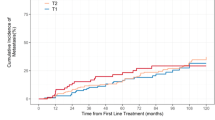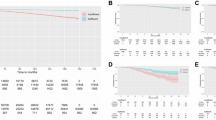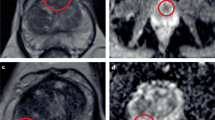Abstract
Treatment choices for men with indolent prostate cancer include active surveillance or definitive local therapy. Overtreatment of these patients is an important current problem. Treatment decisions are often made jointly by the clinician and the patient, partly based on the tumour's Gleason score. To reduce the burden of overtreatment, the clinical significance of Gleason score 3 + 3 = 6 prostate cancer has been questioned and some have advocated that Gleason pattern 3 should be stripped of its cancer status. However, removing the cancer descriptor would have far-reaching clinical consequences that might result in poor patient outcomes, as the evidence of a lack of malignancy is inconclusive in several areas. For example, molecular data suggest that the genomic instability underlying tumour progression precedes histologically visible changes and the absolute risk of metastasis or mortality from Gleason score 6 prostate cancer is not zero. Extreme caution is required when weighing a decision to reclassify Gleason pattern 3 disease as a non-cancer.
This is a preview of subscription content, access via your institution
Access options
Subscribe to this journal
Receive 12 print issues and online access
$209.00 per year
only $17.42 per issue
Buy this article
- Purchase on Springer Link
- Instant access to full article PDF
Prices may be subject to local taxes which are calculated during checkout

Similar content being viewed by others
References
Magi-Galluzzi, C. et al. Gene expression in normal-appearing tissue adjacent to prostate cancers are predictive of clinical outcome: evidence for a biologically meaningful field effect. Oncotarget 7, 33855–33865 (2016).
Gnanapragasam, V. J. et al. The Prostate Health Index adds predictive value to multi-parametric MRI in detecting significant prostate cancers in a repeat biopsy population. Sci. Rep. 6, 35364 (2016).
Haffner, M. C., De Marzo, A. M., Yegnasubramanian, S., Epstein, J. I. & Carter, H. B. Diagnostic challenges of clonal heterogeneity in prostate cancer. J. Clin. Oncol. 33, e38–e40 (2015).
Tosoian, J. J. et al. Intermediate and longer-term outcomes from a prospective active-surveillance program for favorable-risk prostate cancer. J. Clin. Oncol. 33, 3379–3385 (2015).
Bell, K. J., Del Mar, C., Wright, G., Dickinson, J. & Glasziou, P. Prevalence of incidental prostate cancer: a systematic review of autopsy studies. Int. J. Cancer 137, 1749–1757 (2015).
Miah, S., Ahmed, H. U., Freeman, A. & Emberton, M. Does true Gleason pattern 3 merit its cancer descriptor? Nat. Rev. Urol. 13, 541–548 (2016).
Thompson, I. M. et al. Assessing prostate cancer risk: results from the Prostate Cancer Prevention Trial. J. Natl Cancer Inst. 98, 529–534 (2006).
Weiner, A. B., Etzioni, R. & Eggener, S. E. Ongoing Gleason grade migration in localized prostate cancer and implications for use of active surveillance. Eur. Urol. 66, 611–612 (2014).
Danneman, D., Drevin, L., Robinson, D., Stattin, P. & Egevad, L. Gleason inflation 1998–2011: a registry study of 97 168 men. BJU Int. 115, 248–255 (2015).
Albertsen, P. C. et al. Prostate cancer and the Will Rogers phenomenon. J. Natl Cancer Inst. 97, 1248–1253 (2005).
Epstein, J. I., Allsbrook, W. C., Amin, M. B., Egevad, L. L. & ISUP Grading Committee. The 2005 International Society of Urological Pathology (ISUP) consensus conference on Gleason grading of prostatic carcinoma. Am. J. Surg. Pathol. 29, 1228–1242 (2005).
Epstein, J. I. et al. A contemporary prostate cancer grading system: a validated alternative to the Gleason score. Eur. Urol. 69, 428–435 (2016).
Epstein, J. I. et al. The 2014 International Society of Urological Pathology (ISUP) consensus conference on Gleason grading of prostatic carcinoma: definition of grading patterns and proposal for a new grading system. Am. J. Surg. Pathol. 40, 244–252 (2016).
Pierorazio, P. M., Walsh, P. C., Partin, A. W. & Epstein, J. I. Prognostic Gleason grade grouping: data based on the modified Gleason scoring system. BJU Int. 111, 753–760 (2013).
Berman, D. M. & Epstein, J. I. When is prostate cancer really cancer? Urol. Clin. North Am. 41, 339–346 (2014).
Carter, H. B. et al. Gleason score 6 adenocarcinoma: should it be labeled as cancer? J. Clin. Oncol. 30, 4294–4296 (2012).
Sonn, G. A. et al. Initial experience with electronic tracking of specific tumor sites in men undergoing active surveillance of prostate cancer. Urol. Oncol. 32, 952–957 (2014).
Palapattu, G. et al. Molecular progression of Gleason 6 prostate cancer: tracking of specific clones by image-guided biopsy [abstract PD08-07]. J. Urol. 195 (Suppl.), e230–e231 (2016).
Eggener, S. E. et al. Predicting 15-year prostate cancer specific mortality after radical prostatectomy. J. Urol. 185, 869–875 (2011).
Schiffmann, J. et al. Tumor volume in insignificant prostate cancer: increasing threshold gains increasing risk. Prostate 75, 45–49 (2015).
Albertsen, P. C., Hanley, J. A. & Fine, J. 20-year outcomes following conservative management of clinically localized prostate cancer. JAMA 293, 2095–2101 (2005).
Klotz, L. et al. Long-term follow-up of a large active surveillance cohort of patients with prostate cancer. J. Clin. Oncol. 33, 272–277 (2015).
Hamdy, F. C. et al. 10-year outcomes after monitoring, surgery, or radiotherapy for localized prostate cancer. N. Engl. J. Med. 375, 1415–1424 (2016).
Bill-Axelson, A. et al. Radical prostatectomy or watchful waiting in early prostate cancer. N. Engl. J. Med. 370, 932–942 (2014).
Klein, E. A. et al. A 17-gene assay to predict prostate cancer aggressiveness in the context of Gleason grade heterogeneity, tumor multifocality, and biopsy undersampling. Eur. Urol. 66, 550–560 (2014).
Ross, H. M. et al. Do adenocarcinomas of the prostate with Gleason score (GS) ≤6 have the potential to metastasize to lymph nodes? Am. J. Surg. Pathol. 36, 1346–1352 (2012).
Haffner, M. C. et al. Tracking the clonal origin of lethal prostate cancer. J. Clin. Invest. 123, 4918–4922 (2013).
Nakabayashi, M. et al. Clinical predictors of survival in men with castration-resistant prostate cancer: evidence that Gleason score 6 cancer can evolve to lethal disease. Cancer 119, 2990–2998 (2013).
Klein, E. A. et al. Molecular analysis of low grade prostate cancer utilizing a genomic classifier of metastatic potential. J. Urol. http://dx.doi.org/10.1016/j.juro.2016.08.091 (2016).
Karnes, R. J. et al. Validation of a genomic classifier that predicts metastasis following radical prostatectomy in an at risk patient population. J. Urol. 190, 2047–2053 (2013).
Erho, N. et al. Discovery and validation of a prostate cancer genomic classifier that predicts early metastasis following radical prostatectomy. PLoS ONE 8, e66855 (2013).
Lalonde, E. et al. Tumour genomic and microenvironmental heterogeneity for integrated prediction of 5-year biochemical recurrence of prostate cancer: a retrospective cohort study. Lancet Oncol. 15, 1521–1532 (2014).
Polson, E. S. et al. Monoallelic expression of TMPRSS2/ERG in prostate cancer stem cells. Nat. Commun. 4, 1623 (2013).
Lotan, T. L. et al. PTEN loss is associated with upgrading of prostate cancer from biopsy to radical prostatectomy. Mod. Pathol. 28, 128–137 (2015).
Lotan, T. L. et al. PTEN protein loss by immunostaining: analytic validation and prognostic indicator for a high risk surgical cohort of prostate cancer patients. Clin. Cancer Res. 17, 6563–6573 (2011).
Hubbard, G. K. et al. Combined MYC activation and Pten loss are sufficient to create genomic instability and lethal metastatic prostate cancer. Cancer Res. 76, 283–292 (2016).
Gundem, G. et al. The evolutionary history of lethal metastatic prostate cancer. Nature 520, 353–357 (2015).
Cooper, C. S. et al. Analysis of the genetic phylogeny of multifocal prostate cancer identifies multiple independent clonal expansions in neoplastic and morphologically normal prostate tissue. Nat. Genet. 47, 367–372 (2015).
Trock, B. J. et al. PTEN loss and chromosome 8 alterations in Gleason grade 3 prostate cancer cores predicts the presence of un-sampled grade 4 tumor: implications for active surveillance. Mod. Pathol. 29, 764–771 (2016).
Rubin, M. A., Girelli, G. & Demichelis, F. Genomic correlates to the newly proposed grading prognostic groups for prostate cancer. Eur. Urol. 69, 557–560 (2016).
Tomlins, S. A. et al. Characterization of 1577 primary prostate cancers reveals novel biological and clinicopathologic insights into molecular subtypes. Eur. Urol. 68, 555–567 (2015).
Reichard, C. A., Stephenson, A. J. & Klein, E. A. Applying precision medicine to the active surveillance of prostate cancer. Cancer 121, 3403–3411 (2015).
Reichard, C. A., Stephenson, A. J. & Klein, E. A. Molecular markers in urologic oncology: prostate cancer. Curr. Opin. Urol. 26, 225–230 (2016).
Klein, E. A. et al. A genomic classifier improves prediction of metastatic disease within 5 years after surgery in node-negative high-risk prostate cancer patients managed by radical prostatectomy without adjuvant therapy. Eur. Urol. 67, 778–786 (2015).
Klein, E. A. et al. Decipher genomic classifier measured on prostate biopsy predicts metastasis risk. Urology 90, 148–152 (2016).
Author information
Authors and Affiliations
Contributions
C.A.R. researched data for the article and wrote the manuscript. Both authors discussed the article's content and reviewed and/or edited the manuscript before submission.
Corresponding author
Ethics declarations
Competing interests
E.A.K. has served as consultant for GenomeDx, Genomic Health and Metamark, has previously received grant support from GenomeDx, Genomic Health and Metamark, and has received payment for lectures from Genomic Health. C.A.R. declares no competing interest.
PowerPoint slides
Rights and permissions
About this article
Cite this article
Reichard, C., Klein, E. Clinical and molecular rationale to retain the cancer descriptor for Gleason score 6 disease. Nat Rev Urol 14, 59–64 (2017). https://doi.org/10.1038/nrurol.2016.240
Published:
Issue Date:
DOI: https://doi.org/10.1038/nrurol.2016.240



